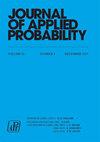布丰问题决定三种几何中的高斯曲率
IF 0.7
4区 数学
Q3 STATISTICS & PROBABILITY
引用次数: 0
摘要
平面中经典布丰问题的一个版本自然延伸到任何具有恒定高斯曲率的黎曼曲面。布丰概率决定了布丰赤字。高斯曲率与布丰缺陷之间的关系类似于贝特朗-迪古埃-普伊塞定理在高斯曲率与周长和面积缺陷之间建立的关系。本文章由计算机程序翻译,如有差异,请以英文原文为准。
Buffon’s problem determines Gaussian curvature in three geometries
A version of the classical Buffon problem in the plane naturally extends to the setting of any Riemannian surface with constant Gaussian curvature. The Buffon probability determines a Buffon deficit. The relationship between Gaussian curvature and the Buffon deficit is similar to the relationship that the Bertrand–Diguet–Puiseux theorem establishes between Gaussian curvature and both circumference and area deficits.
求助全文
通过发布文献求助,成功后即可免费获取论文全文。
去求助
来源期刊

Journal of Applied Probability
数学-统计学与概率论
CiteScore
1.50
自引率
10.00%
发文量
92
审稿时长
6-12 weeks
期刊介绍:
Journal of Applied Probability is the oldest journal devoted to the publication of research in the field of applied probability. It is an international journal published by the Applied Probability Trust, and it serves as a companion publication to the Advances in Applied Probability. Its wide audience includes leading researchers across the entire spectrum of applied probability, including biosciences applications, operations research, telecommunications, computer science, engineering, epidemiology, financial mathematics, the physical and social sciences, and any field where stochastic modeling is used.
A submission to Applied Probability represents a submission that may, at the Editor-in-Chief’s discretion, appear in either the Journal of Applied Probability or the Advances in Applied Probability. Typically, shorter papers appear in the Journal, with longer contributions appearing in the Advances.
 求助内容:
求助内容: 应助结果提醒方式:
应助结果提醒方式:


